Geography > GCSE MARK SCHEME > GCSE (9–1) Geography A (Geographical Themes) J383/03: Geographical skills General Certificate of S (All)
GCSE (9–1) Geography A (Geographical Themes) J383/03: Geographical skills General Certificate of Secondary Education Mark Scheme for November 2020
Document Content and Description Below
GCSE (9–1) Geography A (Geographical Themes) J383/03: Geographical skills General Certificate of Secondary Education Mark Scheme for November 2020 Oxford Cambridge and RSA Examinations GCSE ... (9–1) Geography A (Geographical Themes) J383/03: Geographical skills General Certificate of Secondary Education Mark Scheme for November 2020Oxford Cambridge and RSA Examinations OCR (Oxford Cambridge and RSA) is a leading UK awarding body, providing a wide range of qualifications to meet the needs of candidates of all ages and abilities. OCR qualifications include AS/A Levels, Diplomas, GCSEs, Cambridge Nationals, Cambridge Technicals, Functional Skills, Key Skills, Entry Level qualifications, NVQs and vocational qualifications in areas such as IT, business, languages, teaching/training, administration and secretarial skills. It is also responsible for developing new specifications to meet national requirements and the needs of students and teachers. OCR is a not-for-profit organisation; any surplus made is invested back into the establishment to help towards the development of qualifications and support, which keep pace with the changing needs of today’s society. This mark scheme is published as an aid to teachers and students, to indicate the requirements of the examination. It shows the basis on which marks were awarded by examiners. It does not indicate the details of the discussions which took place at an examiners’ meeting before marking commenced. All examiners are instructed that alternative correct answers and unexpected approaches in candidates’ scripts must be given marks that fairly reflect the relevant knowledge and skills demonstrated. Mark schemes should be read in conjunction with the published question papers and the report on the examination. © OCR 2020J383/03 Mark Scheme November 2020 2 Annotations Annotation Meaning Tick Cross Unclear Level 1 Level 2 Level 3 Development Relevant place detail Communicate findings Significant amount of material which doesn’t answer the question Benefit of doubt Omission mark Blank page Noted not no credit givenJ383/03 Mark Scheme November 2020 3 Subject Specific Marking Instructions INTRODUCTION Your first task as an Examiner is to become thoroughly familiar with the material on which the examination depends. This material includes: • the specification, especially the assessment objectives • the question paper and its rubrics • the mark scheme. You should ensure that you have copies of these materials. You should ensure also that you are familiar with the administrative procedures related to the marking process. These are set out in the OCR booklet Instructions for Examiners. If you are examining for the first time, please read carefully Appendix 5 Introduction to Script Marking: Notes for New Examiners. Please ask for help or guidance whenever you need it. Your first point of contact is your Team Leader.J383/03 Mark Scheme November 2020 4 USING THE MARK SCHEME Please study this Mark Scheme carefully. The Mark Scheme is an integral part of the process that begins with the setting of the question paper and ends with the awarding of grades. Question papers and Mark Schemes are developed in association with each other so that issues of differentiation and positive achievement can be addressed from the very start. This Mark Scheme is a working document; it is not exhaustive; it does not provide ‘correct’ answers. The Mark Scheme can only provide ‘best guesses’ about how the question will work out, and it is subject to revision after we have looked at a wide range of scripts. Please read carefully all the scripts in your allocation and make every effort to look positively for achievement throughout the ability range. Always be prepared to use the full range of marks. LEVELS OF RESPONSE QUESTIONS: The indicative content indicates the expected parameters for candidates’ answers, but be prepared to recognise and credit unexpected approaches where they show relevance. Using ‘best-fit’, decide first which set of level descriptors best describes the overall quality of the answer. Once the level is located, adjust the mark concentrating on features of the answer which make it stronger or weaker following the guidelines for refinement. Highest mark: If clear evidence of all the qualities in the level descriptors is shown, the HIGHEST Mark should be awarded. Lowest mark: If the answer shows the candidate to be borderline (i.e. they have achieved all the qualities of the levels below and show limited evidence of meeting the criteria of the level in question) the LOWEST mark should be awarded. Middle mark: This mark should be used for candidates who are secure in the level. They are not ‘borderline’ but they have only achieved some of the qualities in the level descriptors. Be prepared to use the full range of marks. Do not reserve (e.g.) highest level marks ‘in case’ something turns up of a quality you have not yet seen. If an answer gives clear evidence of the qualities described in the level descriptors, reward appropriately.J383/03 Mark Scheme November 2020 5 AO1 AO2 AO3 Comprehensive A range of detailed and accurate knowledge that is fully relevant to the question. A range of detailed and accurate understanding that is fully relevant to the question. Detailed and accurate interpretation through the application of relevant knowledge and understanding. Detailed and accurate analysis through the application of relevant knowledge and understanding. Detailed and substantiated evaluation through the application of relevant knowledge and understanding. Detailed and substantiated judgement through the application of relevant knowledge and understanding. Thorough A range of accurate knowledge that is relevant to the question. A range of accurate understanding that is relevant to the question. Accurate interpretation through the application of relevant knowledge and understanding. Accurate analysis through the application of relevant knowledge and understanding. Supported evaluation through the application of relevant knowledge and understanding. Supported judgement through the application of relevant knowledge and understanding. Reasonable Some knowledge that is relevant to the question. Some understanding that is relevant to the question. Some accuracy in interpretation through the application of some relevant knowledge and understanding. Some accuracy in analysis through the application of some relevant knowledge and understanding. Partially supported evaluation through the application of some relevant knowledge and understanding. Partially supported judgement through the application of some relevant knowledge and understanding. Basic Limited knowledge that is relevant to the topic or question. Limited understanding that is relevant to the topic or question. Limited accuracy in interpretation through lack of application of relevant knowledge and understanding. Limited accuracy in analysis through lack of application of relevant knowledge and understanding. Un-supported evaluation through lack of application of knowledge and understanding. Un-supported judgement through lack of application of knowledge and understanding.J383/03 Mark Scheme November 2020 6 Question Answer Mark Guidance 1 (a) (i) 5020 () 1 () (ii) D: 496 207 () 1 () (iii) Works/Factories () Cargo Fleet Wharf () Middlesbrough Dock () 1 () Needs to relate specifically to the map, either through named places or using grid references. (b) (i) B: Motel () 1 () (ii) River (Tees) flows through the city () Housing/Building close to the river bank () Urbanised/High building density () increases risk Land is flat () 2 2 x 1 () for identifying reasons (c) Clearer indication of what a high/low flood risk is () Identify/Colour risk in whole area, not just those parts circled () Closer/better scale if looking for just Middlesbrough () Inclusion of scale/ north arrow () 2 2 x 1 () for stating two valid changes (d) Level 3 (5–6 marks) An answer at this level demonstrates a thorough understanding of human activity in river basins and causes of flood events (AO2) with a thorough analysis of whether human activity along river basins increases flood risk in the UK (AO3). This will be shown by including well-developed ideas about whether human activity along river basins increases flood risk in the UK. There are clear and explicit attempts to make appropriate synoptic links between content from different parts of the course of study. 6 This question will be marked using 3 levels: Indicative content Explanation of the impact of human activity on river basins in the UK Evaluation of extent to which this reduces or increases flood risk. Examples of well-developed ideas: Human activity can involve schemes which bring benefit to people in river basins as they can reduce the risk of flooding. For example, reservoirs built in the upper course can store water and control the river flow whilst afforestation can intercept rainfall and slow the surface run-off to the river.J383/03 Mark Scheme November 2020 7 Level 2 (3-4 marks) An answer at this level demonstrates a reasonable understanding of human activity in river basins and causes of flood events (AO2) with a reasonable analysis of whether human activity along river basins increases flood risk in the UK (AO3). This will be shown by including developed ideas about whether human activity along river basins increases flood risk in the UK. There are attempts to make synoptic links between content from different parts of the course of study but these are not always appropriate. Level 1 (1–2 marks) An answer at this level demonstrates a basic understanding of human activity in river basins and causes of flood events (AO2) with a basic analysis of whether human activity along river basins increases flood risk in the UK (AO3). This will be shown by including simple ideas about whether human activity along river basins increases flood risk in the UK. There are no synoptic links between content from different parts of the course of study. 0 marks No response worthy of credit. On the other hand, urbanisation of river basins can increase the flood risk by creating more impermeable surfaces, increasing the speed of surface run-off so that rivers respond to rainfall events more quickly than before. Examples of developed ideas: Flood risk can be increased by human activity when they build on floodplains which means more tarmac or concrete surfaces that do no allow water to soak in and so the water ends up travelling to the river more quickly causing it to rise and burst its banks. Flood prevention method however can reduce the risk in the UK, such as flood walls or river widening. Examples of simple ideas: Humans increase the flood risk by building roads and houses which don’t allow water to soak in. They also try to stop floods by widening the river.J383/03 Mark Scheme November 2020 8 Question Answer Mark Guidance 2 (a) (i) A: From Middlesborough to Skinningrove () 1 () (ii) Flow diagram () Proportional Arrows () 1 () (iii) 20 (difference of 30-10) () 1 () (iv) North arrow () a scale line to show distance between settlements () draw/overlay the flow diagram on a map () show locations on a map () 1 () Credit any reasonable addition. (b) (i) Both rural and urban populations have seen average ages increase () but there has been a greater increase in the average age of rural population () as it increased by about 3 years (DEV) (C) Steady increase in the average age in rural areas () but a slower rate of change seen in urban areas () of less than a year over the time period (DEV) (C) 4 2 x 1 () for describing the pattern of change in the age of the population. 1 x 1 (DEV) for using data from the graph (only one piece of data required) 1 x 1 (COM) for communicating the answer in an appropriate and logical order NB – must be linked to age. (ii) Increase in average age might be due to better health care () / people survive longer as we are able to treat a wider range of illness (DEV). Greater increase in rural areas might be due to internal migration () as many retired people move to the countryside looking for peace and quiet (DEV). Slower increase in urban areas might be due to lower public health standards (). Poor air quality can lead to more respiratory diseases in urban areas (DEV). 4 2 x 1 () for causes 2 x 1 (DEV) for points of explanation. (c) Rural has a greater percentage of elderly/older people/over 50’s () Urban has a greater percentage of young children/0-14yr olds () Urban has a greater percentage of young adults/20-34yr olds () 2 2 x 1 () Do not credit direct oppositesJ383/03 Mark Scheme November 2020 9 Question Answer Mark Guidance 3 (a) (i) C: Tertiary () 1 () (ii) Low levels of technology in the room/ has a blackboard () Room appears to have no walls () Basic construction materials () Corrugated iron roof () 1 () Must be feature of the classroom, not the surroundings, and not something that is not there. (b) (i) Poverty in all regions of southern Ghana has decreased () Poverty increased in northern Ghana from 1990 to 2000 before decreasing () Greatest reduction is in the rural south of Ghana () Least reduction is in the rural north () 3 3 x 1 () Answers must relate to change in poverty levels. No credit for comparison of urban-rural poverty. (ii) Greater investment in the south of Ghana () would create new jobs and improve standard of living (DEV) New Infrastructure projects () can attract new business to the area and bring jobs (DEV) Aid projects () can support improvements in health care so people are able to work (DEV) 4 2 x 1 () for potential reasons for changes 2 x 1 (DEV) for points of explanation. Accept answers relating to a reduction in poverty even if region is not specified (c) 0.402 x 13,800,000 (DEV) = 5,547,600 () 2 1 x 1 () for correct answer 1 x 1 (DEV) for a correct calculation (d) Level 3 (6–8 marks) An answer at this level demonstrates a thorough understanding of the challenges of uneven development in the UK and LIDCs (AO2). There is a thorough evaluation of whether this is a greater challenge for LIDCs (AO3) with a reasonable judgement as to the extent to which the statement is agreed with (AO3). 8 This question will be marked using 3 levels: Indicative Content Candidates need to make the link between the challenges of uneven development for both ACs like the UK and LIDCs like Ghana. Examples of well-developed ideas:J383/03 Mark Scheme November 2020 10 This will be shown by including well-developed ideas about the challenges of uneven development in different contexts. There are clear and explicit attempts to make appropriate synoptic links between content from different parts of the course of study. There is a well-developed line of reasoning which is logically structured. The information presented is relevant and substantiated. Level 2 (3–5 marks) An answer at this level demonstrates a reasonable understanding of the challenges of uneven development in the UK and LIDCs (AO2). There is a reasonable evaluation of whether this is a greater challenge for LIDCs (AO3) with a basic judgement as to the extent to which the statement is agreed with (AO3). This will be shown by including developed ideas about the challenges of uneven development in different global contexts. There are attempts to make synoptic links between content from different parts of the course of study but these are not always appropriate. There is a line of reasoning presented with some structure. The information presented is in the most-part relevant and supported by some evidence. Level 1 (1–2 marks) An answer at this level demonstrates a basic understanding of the challenges of uneven development in the UK and LIDCs (AO2). There is a basic evaluation of whether this is Uneven development in both the UK and in LIDCs brings challenges, however they are different and it could be argued that LIDC’s face much more serious challenges. In LIDCs the challenges of absolute poverty results from a lack of investment in rural areas where poor infrastructure can mean that settlements lack basic facilities such as clean water or electricity. In the UK the lower investment in some areas provides a challenge for the Government and but not to the same degree as the challenges of poverty facing LIDCs. Whilst some areas of the UK are less developed, and poverty is only relative and the government still provides support to ensure that everyone has basic services to support a decent standard of life. Examples of developed ideas: The challenge of uneven development is greater for LIDCs than for the UK. In rural areas of LIDCs there is a lack basic facilities such as water and sanitation. This leads to disease and can shorten life expectancy so is a great challenge. The UK also have problems with uneven development levels with a north south divide but this is more for the lack of jobs in rural areas and long waiting lists for people that need health care. This is not as bad as the challenge of poverty in LIDCs. Examples of simple ideas: There are challenges in the UK and LIDC countries because of uneven development but some areas of LIDCs have much worse living conditions where even water and sanitation is a problem. Most homes in the UK have water piped to them so the challenge is greater in LIDCs.J383/03 Mark Scheme November 2020 11 a bigger challenge for LIDCs (AO3) or a basic judgement as to the extent to which the statement is agreed with (AO3). This will be shown by including simple ideas about the challenges of uneven development. There are no synoptic links between content from different parts of the course of study. 0 marks No response worthy of credit.J383/03 Mark Scheme November 2020 12 Question Answer Mark Guidance 4 (a) Questionnaire () Environmental/Bi-polar survey () People/pedestrian count () Land Use survey () 1 1 x 1 () (b) (i) Site number Pedestrian Count Cumulative Total Cumulative Percentage (to 1 d.p) 10 115 2169 78.6 11 210 2379 86.2 12 105 2484 90.0 13 150 2634 95.4 14 52 2686 97.3 15 75 2761 100.0 () () 2 2 x 1 () 1 mark if one column is correct but other has a mistake. 0 marks if there are mistakes in both columns. (ii) Counts might have been taken at different times () Too many people made it difficult to count accurately () Some people only counted people moving in one direction, others both directions () 1 1 x 1 () (iii) 1 1 x 1 () No credit if line touches either the number ‘75’ or ‘105’. 75 must be to the left of the line 105 must be to the right of the line. (iv) Level 3 (5–6 marks) An answer at this level demonstrates a thorough description of the selected suitable choice of data presentation and explanation of why this is an appropriate choice to present the pedestrian count information (AO4). 6 This question will be marked using 3 levels: Indicative content Description of a selected data presentation method, method (e.g located bar charts, proportional symbols) Explanation of chosen method.J383/03 Mark Scheme November 2020 13 This will be shown by including well-developed ideas. Level 2 (3–4 marks) An answer at this level demonstrates a reasonable description of the selected suitable choice of data presentation and explanation of why this is an appropriate choice to present the pedestrian count information (AO4). This will be shown by including developed ideas. Level 1 (1–2 marks) An answer at this level demonstrates a basic description of the selected suitable choice of data presentation and explanation of why this is an appropriate choice to present the pedestrian count information (AO4). This will be shown by including simple ideas. 0 marks No response worthy of credit. Examples of well-developed ideas: A located bar chart would display the pedestrian flow at different locations in the city; this would include a bar chart at each of the locations where a count has taken place, drawn to the same scale to allow you to compare pedestrian numbers. By including all the sites on the same map, it allows you to analyse the differences in pedestrian numbers as you move away from the town centre. Examples of developed ideas: A located bar chart would display the pedestrian flow; this would include a bar chart at each of the locations where a count took place. By including all the sites on the same map, it allows you to see if there are less people further away from the town centre. Examples of simple ideas: A bar chart at each place where a count was taken. This would let you see if there are less people further away from the town centre. (c) Level 3 (5–6 marks) An answer at this level demonstrates a thorough interpretation of the evidence (AO3) with a thorough analysis of the evidence in the context of the hypothesis (AO3). This will be shown by including well-developed ideas Level 2 (3–4 marks) An answer at this level demonstrates a reasonable interpretation of the evidence (AO3) with a reasonable analysis of the evidence in the context of the hypothesis (AO3). This will be shown by including developed ideas. 6 This question will be marked using 3 levels: Indicative content Analysis of the hypothesis, this could include both the positive and negative reflections on the statement, allowing the candidate to make a judgement on its truth. Examples of well-developed ideas: Most of the data does not support the hypothesis as some of the highest counts e.g site 11 are quite a distance away from the gallery. Whilst the data generally supports the idea that pedestrian numbers decrease as you move further from the gallery, the pattern is not even, with high numbers also being found near the bus station and university of Teesside.J383/03 Mark Scheme November 2020 14 Level 1 (1–2 marks) An answer at this level demonstrates a basic interpretation of the evidence (AO3) with a basic analysis of the evidence in the context of the hypothesis (AO3). This will be shown by including simple ideas. 0 marks No response worthy of credit. Whilst there is some evidence to support the hypothesis, with the lowest two counts being the greatest distance away, overall I do not agree with the idea that the numbers of people decrease in an even manner. Examples of developed ideas: I do not agree with the hypothesis as there are high counts a long way away. Pedestrian numbers do mainly decrease as you move further from the gallery, but there are large numbers also being found near the bus station, nearly as many as at the gallery. Examples of simple ideas: The numbers of people do decrease further away from the gallery but there are also places with high numbers quite far away from the gallery.J383/03 Mark Scheme November 2020 15 Question Answer Mark Guidance 5 (a) Area was regarded as a safe location for fieldwork () Easily accessible from the school () A suitable size for a fieldwork investigation () 1 1 x 1 () Accept any reasonable answer which relates to the title given. (b) The Bradshaw model helped us set our hypothesis that the river would get wider downstream. () This meant that we had a clear basis which we could use to test our measurements (). Provided guidance on how we should expect the velocity of the water to change along the course ().This helped us to evaluate the accuracy of our measurements. () By studying the management on the Hornsea coast we had something to compare our results to (). We could see if there were different rates of longshore drift at different locations (). The case study supported our conclusions that management was not effective () as we could see another example of where measures had been taken that were more effective (). 4 4 x 1 () for valid explanation points of how a theory or case study could be used to support the investigation (c) Level 3 (6–8 marks) An answer at this level demonstrates a thorough evaluation for the strength of conclusions reached (AO3) with a thorough judgement as to the extent to which the data enabled a strong conclusion to be reached (AO3). This will be shown by including well-developed ideas. There is a well-developed line of reasoning which is clear and logically structured. The information presented is relevant and substantiated. Level 2 (3–5 marks) 8 This question will be marked using 3 levels: Indicative content Evaluation of strength of conclusion based on evidence from fieldwork investigation Data from the investigation should be used as evidence Justification of conclusion through evaluated evidence Examples of well-developed ideas: (river study) One conclusion that we reached was that the River Aire increased in velocity as you move downstream. This was not a very strong conclusion however as the data did not clearly identify an increase at each site downstream and theJ383/03 Mark Scheme November 2020 16 An answer at this level demonstrates reasonable evaluation for the strength of conclusions reached (AO3) with a reasonable judgement as to the extent to which the data enabled a strong conclusion to be reached (AO3). This will be shown by including developed ideas. There is a line of reasoning presented with some structure. The information presented is in the most-part relevant and supported by some evidence. Level 1 (1–2 marks) An answer at this level demonstrates a basic evaluation for the strength of conclusions reached (AO3) with a basic judgement as to the extent to which the data enabled a strong conclusion to be reached (AO3). This will be shown by including simple ideas. The information is basic and communicated in an unstructured way. The information is supported by limited evidence and the relationship to the evidence may not be clear. 0 marks No response worthy of credit. limitations of our methods, using an orange float, meant that their accuracy could also be questioned. Our conclusion that width and depth increased downstream however was more strongly supported by our data. The rivers’ width increased at each site downstream, whilst our cross sections displayed that there was a clear difference in the depth of the stream with a peak depth of only 20cm at site 1 but 1.5m at site 5. Examples of developed ideas: One conclusion that we reached was that the River Aire increased in velocity. However the data was not very clear and we only used an orange float, which meant that the accuracy of the data was not very good. could also be questioned. Our conclusion that width and depth increased downstream however was stronger The rivers’ width increased at each site downstream, and there was a clear difference in the depth of the stream with site 1 being much shallower than site 5. Examples of simple ideas: One conclusion that we reached was that the River Aire increased in speed. This was not very clear though and the data was not very accurate. We also said that the width and depth increased at each site, this was strong because the data showed the stream get much deeper with site 1 being much shallower than site 5. Spelling, punctuation and grammar and the use of specialist terminology (SPaG) are assessed using the separate marking grid in Appendix 1. 3J383/03 Mark Scheme November 2020 17 APPENDIX 1 Spelling, punctuation and grammar and the use of specialist terminology (SPaG) assessment grid * High performance 3 marks • Learners spell and punctuate with consistent accuracy • Learners use rules of grammar with effective control of meaning overall • Learners use a wide range of specialist terms as appropriate Intermediate performance 2 marks • Learners spell and punctuate with considerable accuracy • Learners use rules of grammar with general control of meaning overall • Learners use a good range of specialist terms as appropriate Threshold performance 1 mark • Learners spell and punctuate with reasonable accuracy • Learners use rules of grammar with some control of meaning and any errors do not significantly hinder overall • Learners use a limited range of specialist terms as appropriate 0 marks • The learner writes nothing • The learner’s response does not relate to the question • The learner’s achievement in SPaG does not reach the threshold performance level, for example errors in spelling, punctuation and grammar severely hinder meaningOCR (Oxford Cambridge and RSA Examinations) The Triangle Building Shaftesbury Road Cambridge CB2 8EA [Show More]
Last updated: 2 years ago
Preview 1 out of 19 pages

Buy this document to get the full access instantly
Instant Download Access after purchase
Buy NowInstant download
We Accept:

Reviews( 0 )
$7.00
Can't find what you want? Try our AI powered Search
Document information
Connected school, study & course
About the document
Uploaded On
Oct 07, 2022
Number of pages
19
Written in
Additional information
This document has been written for:
Uploaded
Oct 07, 2022
Downloads
0
Views
78

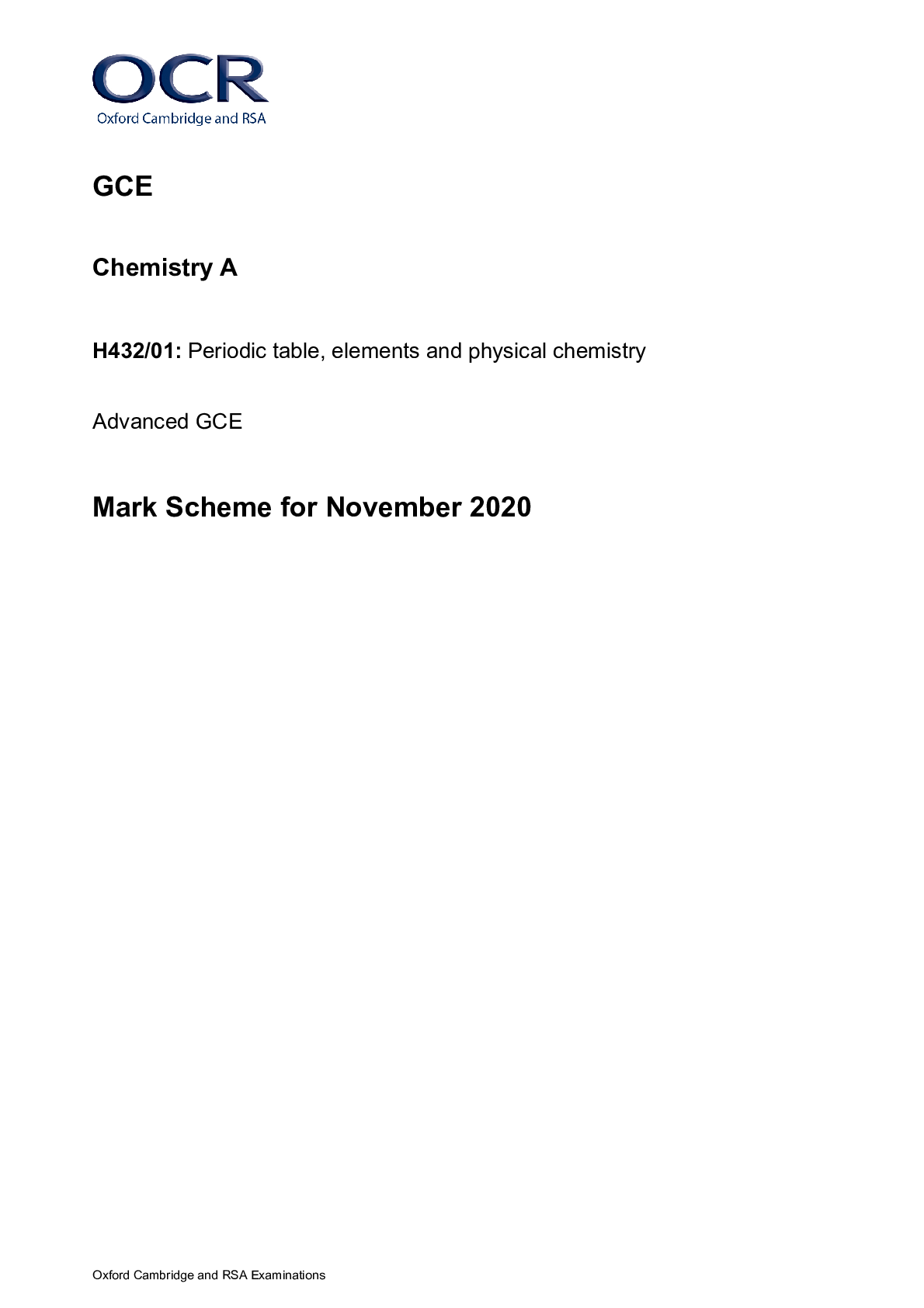


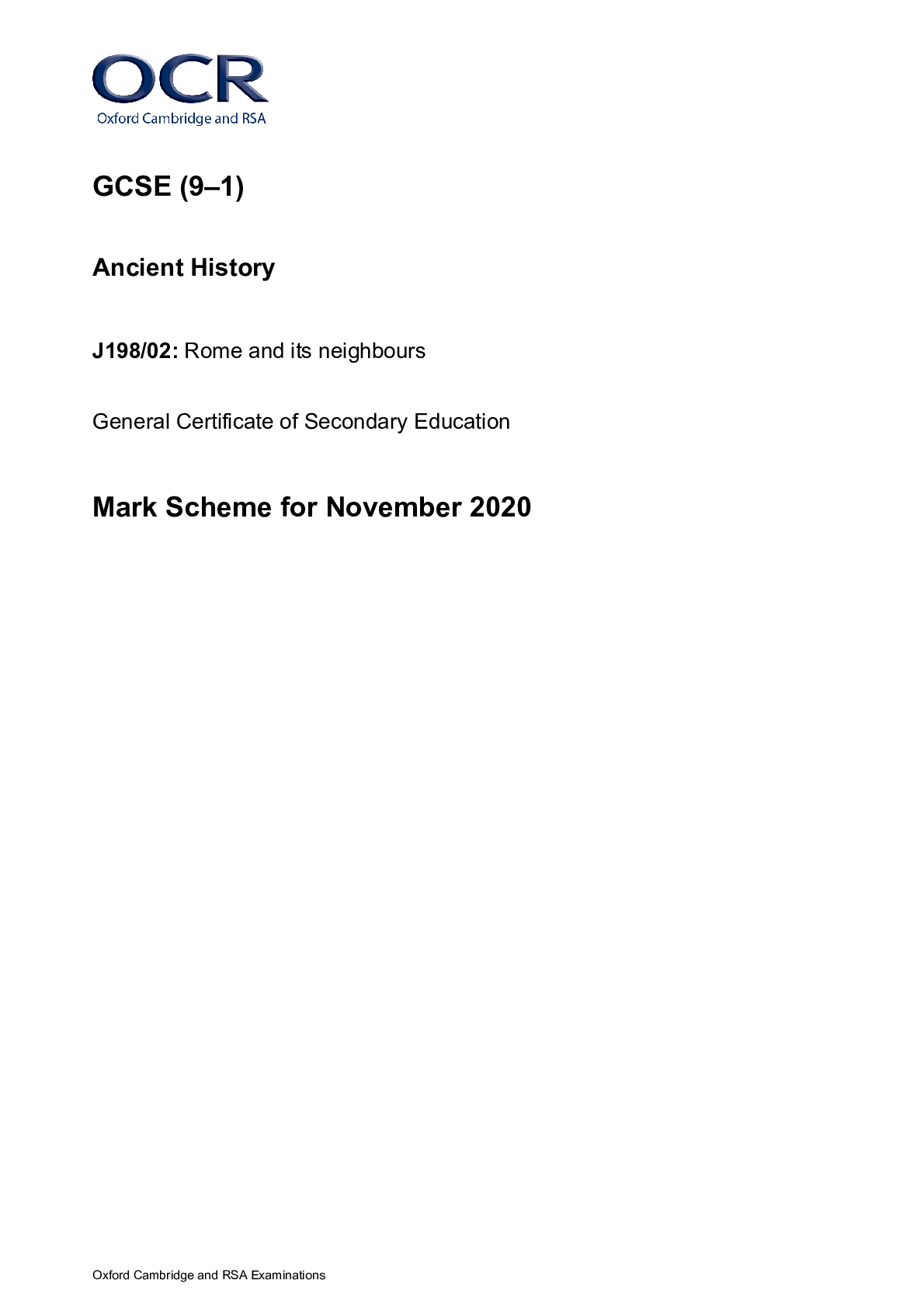




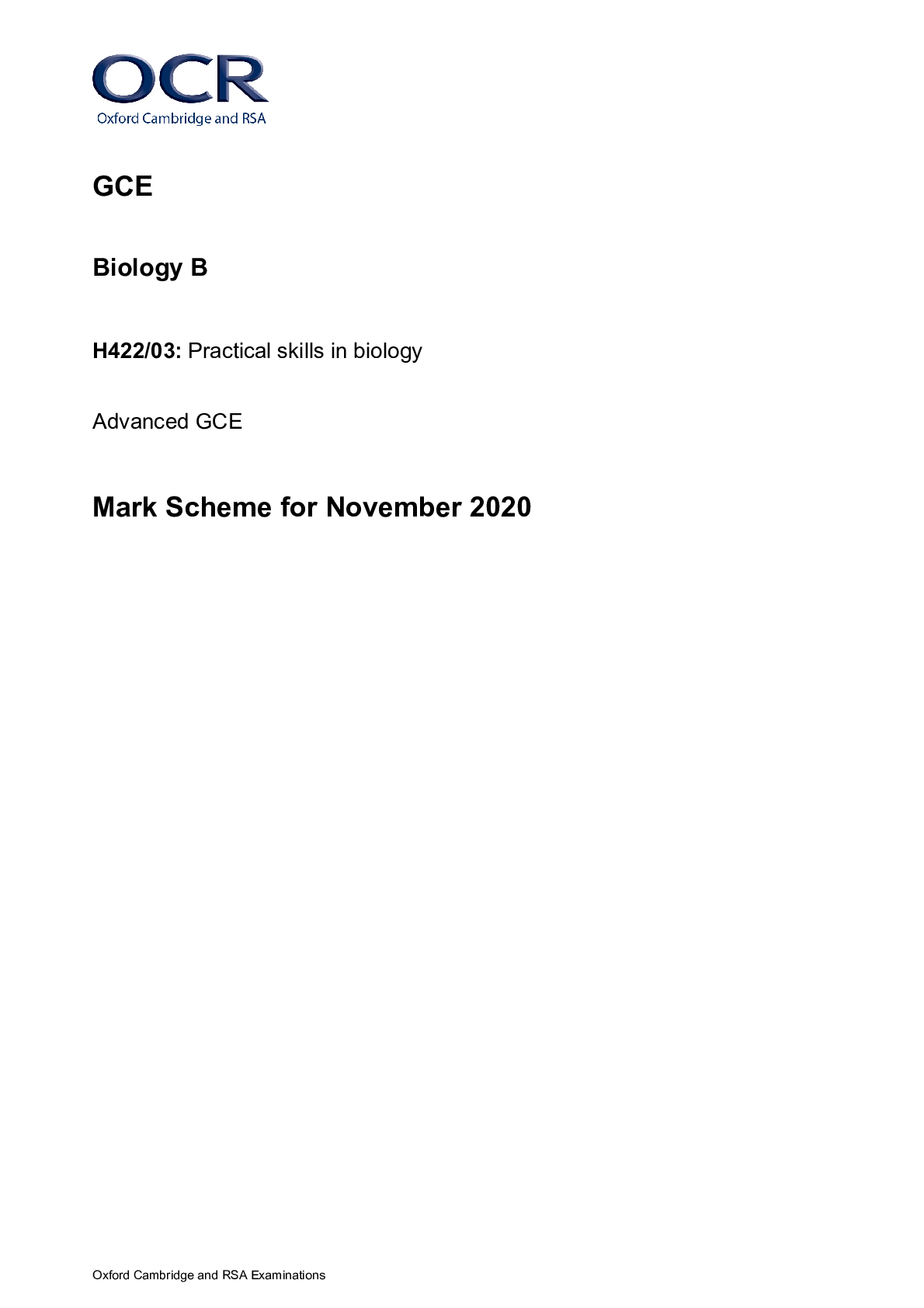
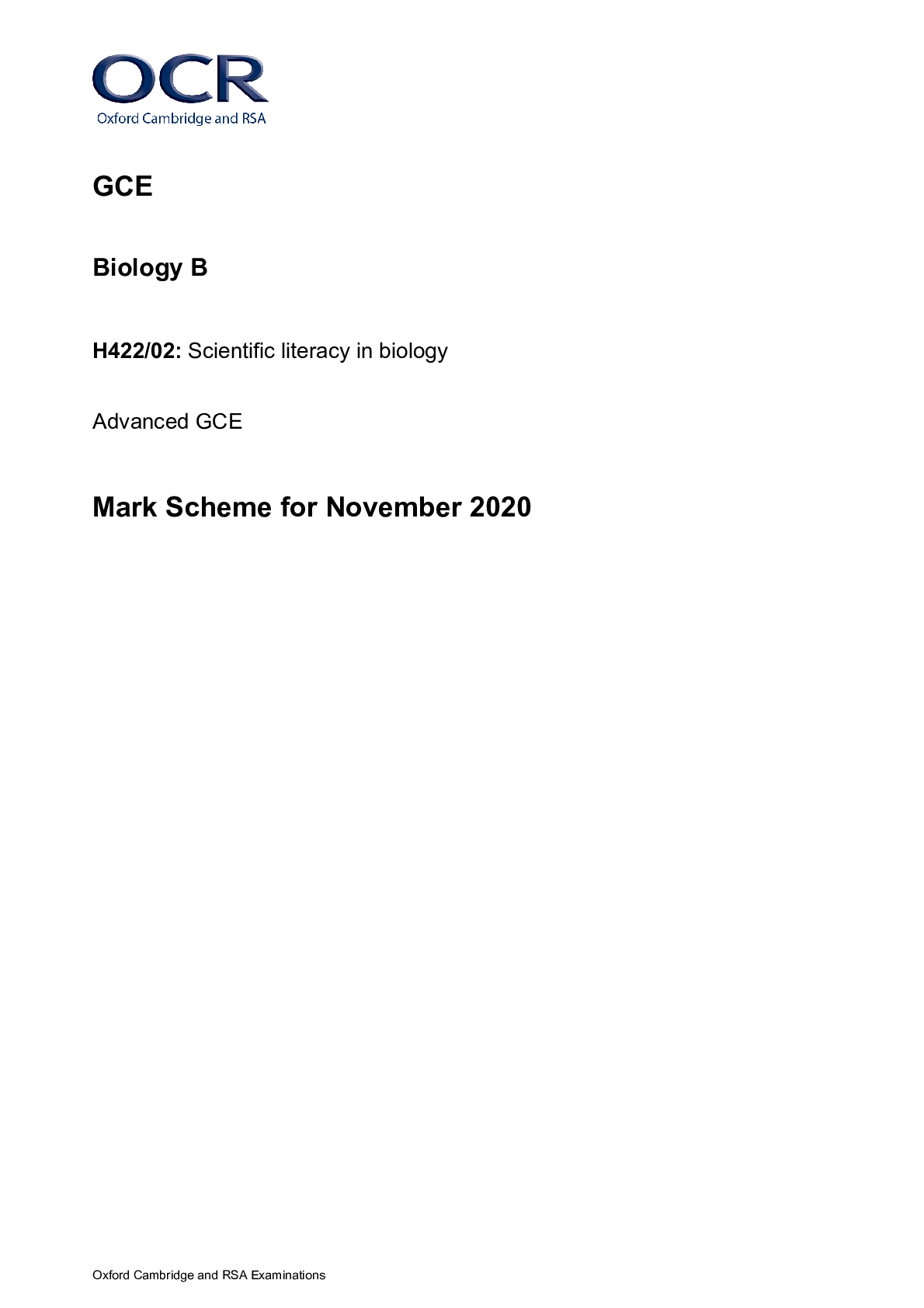
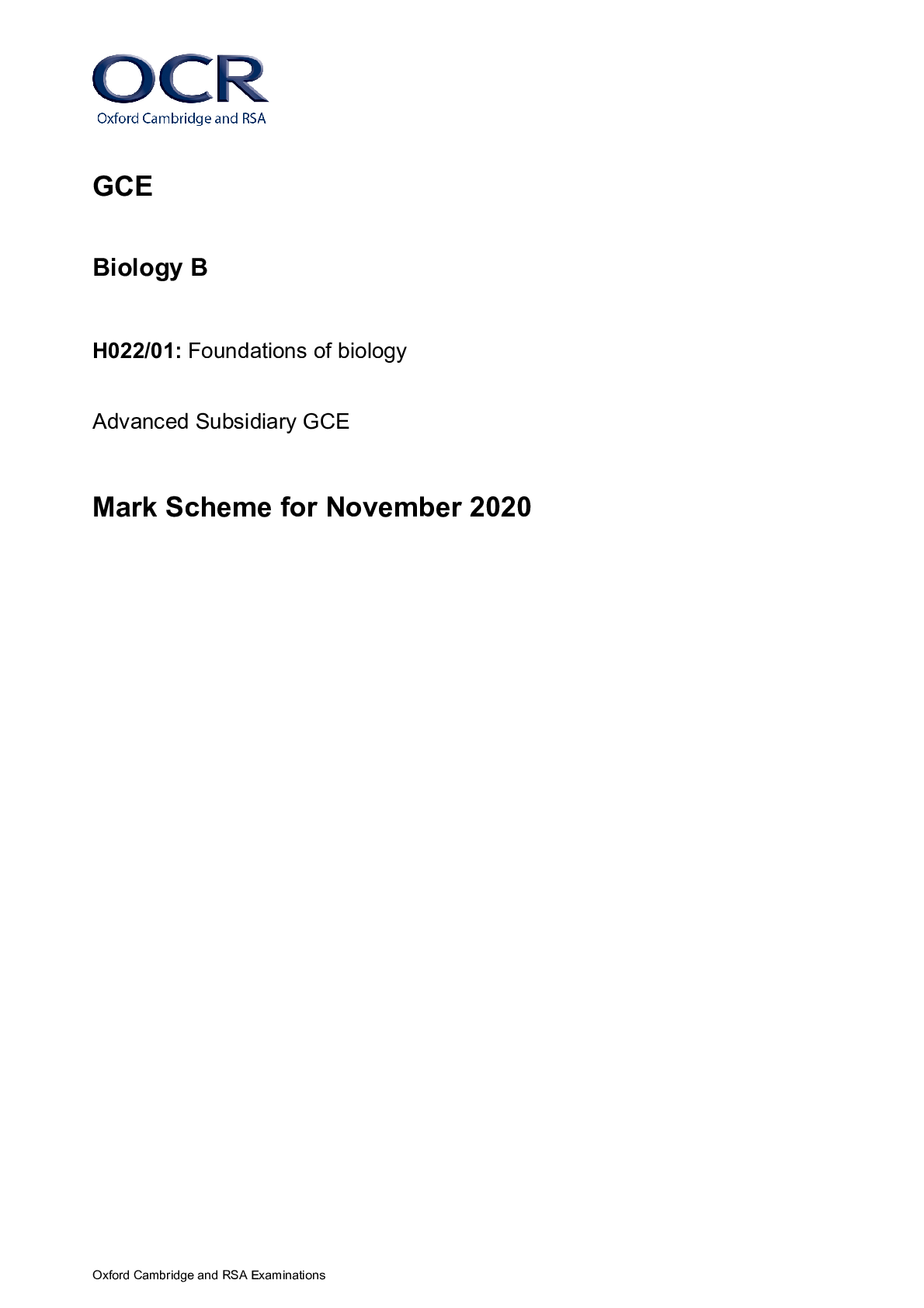

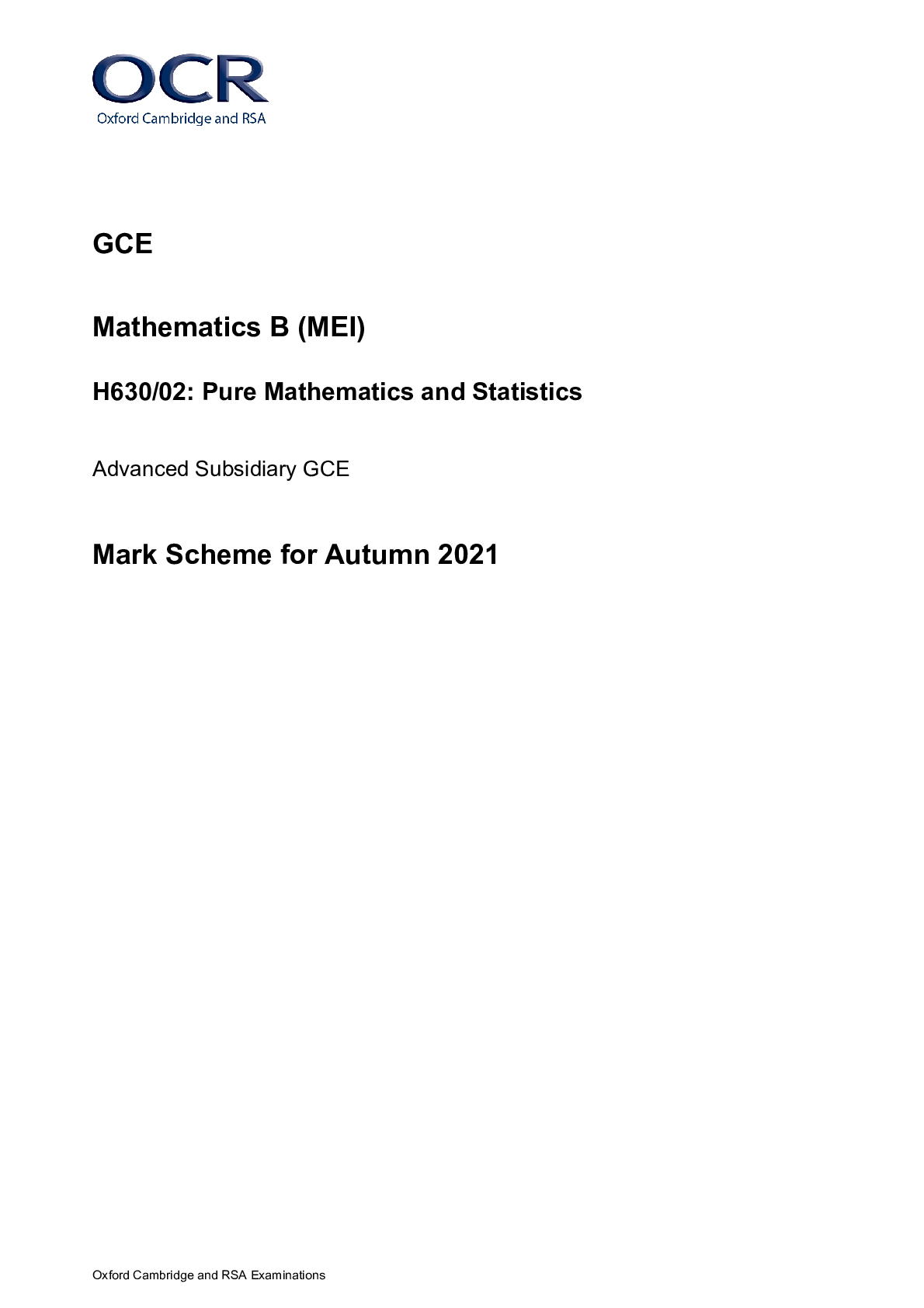


.png)
H630-02 Pure Mathematics and Statistics Advanced Subsidiary GCE Mark Scheme for Autumn 2021.png)




